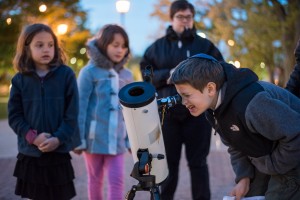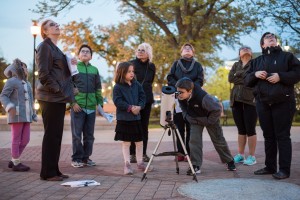Here at Skokie Public Library, one of our favorite seasonal recurring events is our Stargazer Night program. While we first started these all-ages programs in the spring of 2015 in conjunction with an exploration of microcosms and macrocosms in our BOOMbox, we’ve continued offering 5 or 6 of these programs each year. Here’s what we do.
First, we choose our dates for Stargazer Night programs. We check a local sunrise/sunset schedule so we know what months might be viable for a program. We’ve tended to find that February, March, September, October, and November are the best for temperate evenings with enough darkness before the library closes at 9 p.m. Next we look for interesting astronomical events during our chosen months; if possible, we like to offer Stargazer Nights on the night of a meteor shower, a good night for viewing the moon, or when one or more planets will be visible with our telescopes. We’ve found that this Astronomy Calendar of Celestial Events is a great resource for choosing nights.
We always use the same space for Stargazer Nights: the Village Green directly outside one of the library’s entrances. This public park space offers flat surfaces away from traffic and tree cover yet in the clear pathway of library visitors–a great combination of optimal stargazing space and serendipitous discovery on the part of potential participants.
At the beginning of each program, our staff member leading the program brings the following supplies to the Village Green:
- Celestron Cometron 114AZ telescope
- Celestron PowerSeeker 50AZ telescope
- Binoculars
- iPad with stargazing/star map app (we really like SkySafari)
- Printed sky maps for the month from Skymaps.com for folks to take home
With all supplies ready to go, we’re able to start engaging patrons in some stargazing. We’ve found that one major activity we conduct at each and every Stargazer Night is an exploration of the telescopes and how they work. For a good number of our participants, this program is their first experience with an actual telescope. We talk about how telescopes work; telescope viewing tips; and how the lenses and magnification of telescope result in an inverse image, similar to when you look at your reflection on a spoon. It always leaves us feeling great to know that folks at these programs–spanning from very young children to senior citizens–have had their first experience using a telescope because of a free library program. And it’s not just library staff sharing knowledge about space and stargazing–often participants will share their own knowledge and enthusiasm as well, whether it’s acquired through reading or previous hands-on astronomy experiences.
The rest of our activities for each night are determined by what we might be trying to view. Is it a great night for observing the moon? We’ll point the telescopes and binoculars at the moon, talk about how the tides work, and discuss the phases of the moon. Are we looking at planets? With the telescopes focused on the planet in question, we’ll talk about the solar system, planetary moons, and how much we would weigh on different planets based on their gravity. If we’re looking for meteors or are stargazing during a new moon, we’ll spend time identifying constellations and telling the myths that accompany many of them. Regardless of what we’re looking at in the sky, we have plenty to discuss and explore.
And if the weather is a bit overcast? We’ll still hang outside as long as it’s not precipitating. In the event of a less-than-visible sky, we’ll make a game out of training the telescope on an object in the village’s skyline, then get attendees to try to identify each object with the naked eye or with the binoculars. Even a cloudy night is an opportunity for some telescope skills acquisition.
We’ve offered over a dozen Stargazer Nights at this point, with plans to offer three more this fall while our library is hosting an exhibit called Explore Space (which we’ll host as a recipient of a grant from STAR_Net!). We’re looking forward to seeing if we can replicate some of our best skygazing accomplishments: seeing Jupiter and four of its moons, seeing some meteors, and identifying craters on the moon.
Have you ever hosted a stargazing program? If not, now’s a great time to scout out a location at your library and look into getting the equipment you need. And if purchasing telescopes is beyond your budget, don’t forget you can reach out to local amateur astronomers clubs to invite them to lead a program with you. There are many ways to stargaze at the library!






Leave A Comment